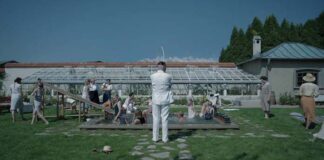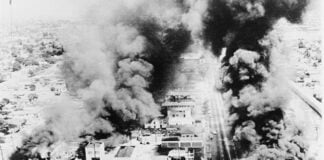Mad Square
Modernity in German Art 1910-1937, formerly at Melbourne NGV
“A dissolution of the social order was expected by the hour” said the German Minister of Finance in 1923, reflecting on the revolutionary year just passed. The artworks in Mad Square certainly give a sense of incredible social instability in Germany between 1910-1937 and the contest between revolution and reaction.
Expressionists and WWI
The exhibition begins with nightmarish paintings of apocalypse and destruction. Artists like George Grosz, Max Beckmann and Otto Dix lived through the battlefields of WWI. They were horrified to learn the truth behind the hollow pro-war patriotism that even the German Social Democratic Party (SPD) promoted in 1914. These artists’ sense of betrayal and trauma is visible in images of the war wounded, syphilitic prostitutes, death, suicide, extreme poverty and sexual violence.
Towards the end of WWI German workers and soldiers began to turn their war against Russia into a war against their own ruling class. The naked class conflict is captured by Grosz’s series The Robbers, juxtaposing the undeserving wealth of the capitalist class against the stark poverty of the majority. As strikes and mutinies of millions developed into revolution, artists of this period formed an artists’ soviet and produced revolutionary posters encouraging workers’ power.
Nowhere in the exhibition cues does it say that the revolution was brutally crushed. But a few artworks give it away. One by Cesar Klein reads “Whoever does not work is the gravedigger for his own children”. The other, by Johannes Safis, shows a Russian wolf lurking over a pool of red blood with a destroyed city in the background, and reads “Bolshevism means to drown the world in blood”.
And sure enough there was a blood bath—but it was not unleashed by the Bolsheviks, or the revolutionaries in Germany.
The image of the brutal counter-revolution is a woodcut by Kathe Kollwitz called Memorial for Karl Liebknecht that shows workers mourning his murder at the hands of the Freikorps, the highly-paid mercenary force put together by the SPD leadership for the express purpose of killing off the revolution. These thugs were the first modern Germans to use the swastika as their symbol.
Dada
The art of the radical Dada movement captures the entirely unsettled and unresolved social and political tensions that followed the leaders of the counter-revolution into the Weimar period.
Balance, by Hannah Hoch is, ironically, a destabilising sight. Two figures assembled out of the body parts of adults and children, males and females, precariously prop each other up on the edge of a plank. The unfinished, ripped edges, and the sense that all component parts of this collage could easily collapse, reflect the instability and crisis still endemic in Germany throughout the 1920s.
The ruling class turned again to the extreme right to help reinforce the crumbling social order, and the Nazis climbed to power in the 1930s with the support of the very wealthy.
John Heartfield, leading Dadaist and member of the Communist Party, created urgent, searing critiques of Hitler’s propaganda and the role of capital in the rise of the Nazis. Adolf, the Superman: swallows gold and spouts rubbish connects the wealthy industrialists of the Rhur and their investment in the fascist party through photomontage.
Similarly, The meaning of Geneva: where capital lives, peace cannot live shows the dove of peace bayoneted in front of the League of Nations headquarters. The image punctures illusions that the collaboration of imperialist powers in the League of Nations (precursor to United Nations) could have averted the rise of fascism.
Degenerate Art
In 1933 the Nazis seized power and took control of cultural life. Goebbels, as head of propaganda, removed “undesirable” museum directors and university professors.
The Nazis confiscated approximately 20,000 works by more than 1400 artists. German artists fled into exile or were interned and killed in concentration camps. Felix Nussbaum painted The Mad Square in 1931, depicting the rise of a menacing force. In 1944 he was deported to Auschwitz where he died.
The last art works in the exhibition are photos of the Nazi’s Degenerate Art exhibitions. Audiences were encouraged to disapprove of and ridicule socially and artistically progressive works. They were presented under inflammatory and racist slogans, like “Revelation of the Jewish racial soul”, and “Paid for by the taxes of the German working people”. Fascism had killed off the Modernist art movement along with hopes for a revolution in Germany.
Trotsky said that “art, like science, not only does not seek orders, but by its very essence, cannot tolerate them.” The art of Mad Square provides an excellent example of the rebelliousness and creativity of artists rejecting the social order and giving expression to revolutionary discontent.
By Lucy Honan





